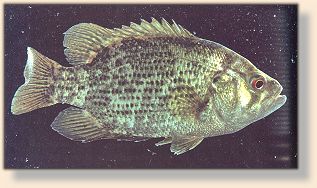Many fishermen know the rock bass as google-eye or redeye, names
derived from the fish's bulging, reddish-colored eyes.

The rock bass is a member of the sunfish family, but is not a true bass. Its sides are
mottled with dark brown on a lighter background. The fish can change color in
chameleon fashion, losing it's dark brown mottling in a matter of seconds.
Like most sunfish, rock bass seldom exceed 2 pounds. The world record is shared
by a pair of 3-pound fish, one from the York River, Ontario in 1974 and the other from
Sugar Creek, Indiana in 1979.
The original range of rock bass covered the eastern half of the United States and into
southern Canada, with the exception of states along the Eastern Seaboard. Rock bass
have been stocked in states both east and west of the native range.
In the southern half of its range, the rock bass thrives in clear, warmwater streams
with rocky bottoms. These streams produce the largest fish.

Rock bass differ from warmouth and other true sunfish in that they have six spines on the
anal fin instead of three. Each scale below the lateral line has a dark spot, forming eight
to ten rows of horizontal lines.
Fishermen in the North catch most rock bass in relatively clear lakes with moderate
vegetation. Fish in weedy lakes seldom reach acceptable size.
Rock bass in northern lakes spawn from late May to late June, usually in water from
65 to 70 degrees F. But in southern streams, they spawn in March and April at
substantially lower temperatures, generally 55 to 60 degrees F. They build saucer-shaped
nests near rocks, weeds or woody cover. Most nest on sand or gravel bottoms in water
only 1 to 4 feet deep. Unlike sunfish, they seldom nest in colonies.
Primarily bottom feeders, rock bass will take insects on the surface, especially in streams.
They usually feed during the day.
Rock bass in both lakes and streams spend most of their time in a relatively small area.
In late fall, they become nearly dormant, feeding very little once the water temperatures
drops below 45 degrees F.
STREAMS
In spring, rock bass may leave their home territory to find a suitable spawning area.
Look for spawners in eddies just off the main channel, below rock ledges and undercut
banks, and just downstream of dams, rocks and logs.
After spawning, rock bass use the same type of cover but in deeper water. Strong
sunlight will force them into deep pools or heavily shaded areas. But they leave cover
in early morning or evening to feed in shallow riffles or in the upper portions of pools
where current carries in food. This pattern continues into fall.
Weather has little impact on rock bass in streams. On cloudy days, or when runoff
muddies the water, the fish do not hold as tight to cover.
NATURAL LAKES
Rock bass spawn along sand or gravel shorelines, usually near emergent vegetation
like bulrushes. Anglers also look for overhanging branches, fallen trees, brush and
large boulders where spawning fish can find shade.
In summer, rock bass school on structure in deeper water, usually from 10 to 20 feet.
Look for rocky reefs and points, or humps with sand or gravel bottoms. The fish also
hold along submerged weedlines, often intermingling with sunfish.
Rock bass edge back into shallow water in fall, but seldom move as shallow as in spring.
Credits: From The Freshwater Angler Panfish published by
Cowles Creative Publishing, Inc. We appreciate use permission!
|


